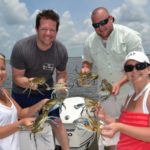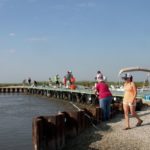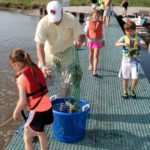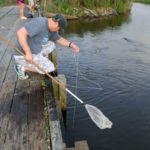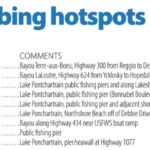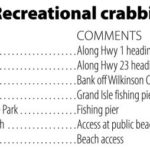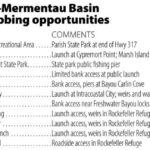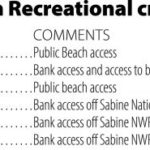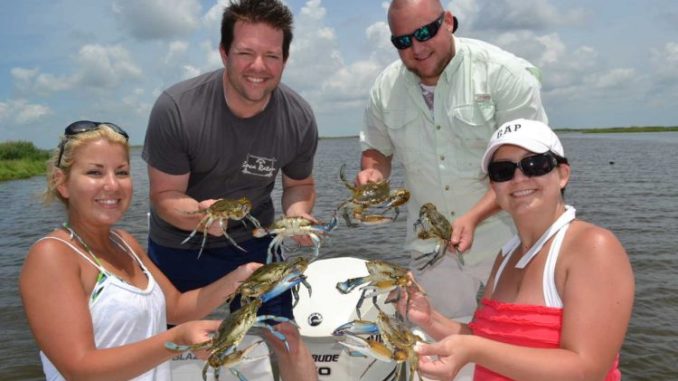
There are few more-relaxing pastimes than crabbing, and the results are loads of delicious meat. So load up the kids and head to one of these public crabbing hotspots.
The first time I ate crabs was way back in the summer of 1984. I’m not talking about those Alaskan king crab legs that are rapidly processed, quick-frozen and shipped to a chain restaurant or grocery near you.
It certainly wasn’t good old Louisiana blue crabs.
That changed when I moved to Louisiana. Back then our little family lived in a modest single-wide trailer located in Fanco Trailer Park along Bayou Teche in Bayou Vista.
We had access to a private wharf and a few crab traps that I’d bait with some catfish heads my wife Christine’s grandfather would give us from the lines he ran.
Life was simple. When I got off work, we’d walk to the bayou to see what we caught. Without fail, just like the day before, there were always enough crabs — a dozen or more — to boil.
I’d empty the traps into a 5-gallon plastic bucket, rebait the traps and toss them back into the water.
That went on for quite some time, until one day, my pants size changed. I went from weighing a svelte 197 pounds to a chunky 217.
The summer of ’84 I put on 20 pounds eating the most delectable, delicious, sweetest meat I had ever tasted.
Last summer, I made a trip to Marsh Island with a couple of buddies in search of some clear water. With the intent of catching a few fish, we arrived at one of the island’s many weirs, where several families were having a blast.
With nothing more than a few pieces of string, plenty of chicken and dip nets, they were catching crabs — the pretty blue-clawed kind.
There we were, with not one piece of chicken or crab bait in the boat to switch to a plan B.
And that family was catching the tasty crustaceans like nobody’s business.
Someone I happened to strike up a conversation with while out on the island was Howard Scully, a native of Morgan City who resides in Baton Rouge.
While dumping some pretty crabs he just caught into a basket, Scully said he’d had trips like the one that family was enjoying.
“I came out here with my brother and godchild,” Scully said. “Man! We caught some pretty crabs. And all of us caught our 12 dozen limits that day.”
Those words weren’t all that surprising. The island has several weirs and water-control structures the Louisiana Department of Wildlife and Fisheries has set up for recreational crabbing and shrimping.
In fact, all across Louisiana’s coastline there are so much public crabbing opportunities you just might need an increase in your budget for a new wardrobe.
And the mid-summer months tend to be the best when it comes to recreational crabbing, according to LDWF Crustacean Biologist Jeff Marx.
“Crabbing depends on where you’re at recreationally,” Marx said. “Sometimes you have freshwater that has saltwater influence. Sometimes it depends on if they’re running.
“But, once you get into the warmer summer months of June, July and August it’s usually pretty good.”
The one thing that made our afternoon trips to the bayou in back of the trailer park so special all those years ago was the daily excitement of the kids.
On one hand, they would have this sort of apprehension that comes with getting pinched by a blue crab. But on the other hand, their daring inquisitiveness and emotional brush with something they deemed dangerous made them more confident with each afternoon encounter.
Moise Guillot, who has a camp on Cypremort Point, was also out on Marsh Island with his family the day I spoke with Scully.
Guillot, talking about the crabbing pier where he and his family were catching their crabs said the island is perfect.
“It’s a great place to bring the kids,” he said. “It had been at least 10 years since I’d been out here. The (LDWF) really have this place fixed up nice.
“When we first got here this morning there was nobody here, but now it’s pretty crowded.”
Crowded or not, there is plenty of room on Marsh Island and many of the other recreational areas the department has set up for crabbing or throwing a cast net for shrimp.
When Bayou Guide Service’s Capt. Bill Lake takes a break from fishing to go crabbing, he prefers Point-aux-Chene WMA southeast of Houma.
And to avoid crowds, he goes by boat.
“Let me tell you, these crabs are so plentiful it’s unreal,” Lake said. “What we do is go out on the reserve itself; it’s illegal to crab commercially there. So when we go, we catch some real monsters.
“And what we do is put out small crab nets — not crab traps, but the round two-ring crab nets. You just put your bait in the center and drop them in the water. We have cork floats on them and put out about 40 nets 20 to 30 yards apart.”
Then it’s just a matter of giving the crabs time to find the bait.
“We’ll let them sit approximately 20 to 30 minutes, and then go run them,” Lake said. “It’s just like raising up a crawfish net.
“All you do is bait the nets up, pick them up, dump them in a tub and grade them, throw the skinny ones back and keep the full ones.”
It can be very productive.
“Sometimes on one pass we’ll catch as many as 60 crabs,” the fishing guide said. “We’ll then go back and make another pass. Typically we’re finished crabbing by 8 or 9 o’clock if we start right at daylight.
“You can only catch a 12-dozen limit, so that’s plenty to eat.”
An added incentive for crabbers this year is the possibility of catching crab with $5 or $50 reward tags attached.
Log onto LouisianaSportsman.com/tagged-crabs to read more about this Nicholls State University program.
The nice part about recreational crabbing is there is very little cost to get in on the fun. Two-ring nets like the ones Lake uses cost no more than $3 dollars each at your local hardware store or bait shop — probably a few dollars more at a marina.
But, you don’t have to get fancy: A sturdy string with bait tied to it and a dip net, works well too.
In the years since my introduction to blue crabs, I’ve learned you can bait traps and nets for the crustaceans with just about anything.
The most obvious and easiest bait to obtain is chicken parts, which are cheap and plentiful.
But carcasses of fish you cleaned, pogies and turkey necks all work.
And you don’t even have to launch a boat and go out to Marsh Island to enjoy a day of catching crabs. Day trips to places like Grand Isle State Park in the east, Sabine National Wildlife Refuge in the west and dozens of public facilities set up for crabbers in between make this recreational activity available to everyone.
But, be careful. Eating too many crabs can be hazardous to your waistline.
